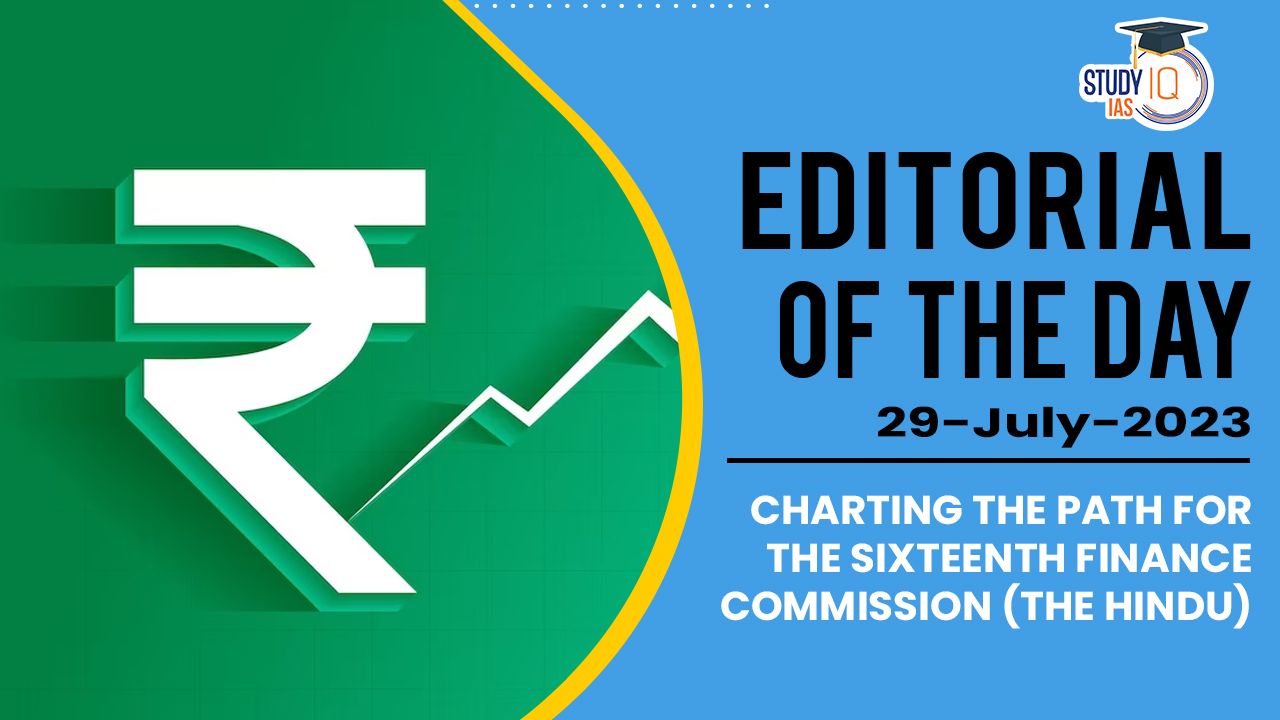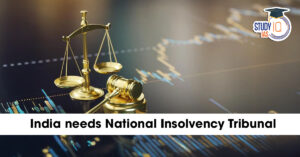Table of Contents
Context: The article is discussing the upcoming establishment of the Sixteenth Finance Commission. It highlights several critical changes (COVID-19 pandemic and subsequent geopolitical challenges) that have occurred since the formation of the previous commission, the Fifteenth Finance Commission, in 2017. One major concern mentioned in the article is the combined government debt-GDP ratio, which had risen close to 90% by the end of the financial year 2020-2021 that indicates a substantial increase in the debt burden compared to the size of the economy. Furthermore, the article points out that many states in the country are experiencing significant fiscal imbalances. It addresses these issues by suggesting several areas that require attention. Overall, the article is addressing the challenges and areas of concern that the Sixteenth Finance Commission needs to consider and address in its role of recommending fiscal policies and fund allocations between the central government and the states.
Background
About the Finance Commission:
- The Finance Commission is a Constitutionally mandated body that is at the centre of fiscal federalism.
- According to the provisions of Article 280, the President of India constitutes the Finance Commission every five years or on time considered necessary by him.
- Objectives: Its core responsibility is to –
- Evaluate the state of finances of the Union and State Governments,
- Recommend the sharing of taxes between them,
- Lay down the principles determining the distribution of these taxes among States.
- Composition of Finance Commission: The Finance Commission includes the Chairman and four other members appointed by the President itself.
- The qualification of the commissioner and the other four members is determined by the elected parliament and by formulating appropriate laws.
- Accordingly, the parliament enacted the Finance Commission (Miscellaneous Provision) Act 1951, which stipulates that The Chairman should be a person with a good experience in the field of public affairs and the other four members needs to be from the following:
- High Court Judge or qualified to be the HC Judge.
- Need to have specialized Knowledge of Accounts and Finance of the Indian Government.
- Vastly experienced in the field of administration and finance.
- Specialised knowledge in the field of economics.
- The Finance Commission submits its report to the President of India, who then presents it to either house of Parliament for taking necessary action on the recommendation.
- However, Finance Commission reports are advisory in nature only hence it is not binding on the government.
- At present the 15th Finance Commission has been constituted for the period of 2021 – 2026 under the chairmanship of NK Singh.
Decoding the Editorial
The article is addressing various issues by suggesting several areas that require attention.
- First, it emphasises the need to correct excessive cesses.
- Cesses are additional levies imposed on specific goods or services to fund specific purposes.
- If not properly managed, excessive cesses can lead to distortions in the tax system and affect overall fiscal health.
- Second, freezing the weight for the income distance criterion is proposed.
- The income distance criterion is used by the Finance Commission to allocate funds to states based on their income disparities.
- Freezing the weight for this criterion could have implications for how funds are distributed among states.
- Lastly, the article calls for sharper monitoring of the fiscal deficit.
- Fiscal deficit refers to the gap between a government’s total expenditure and its total revenue, which is often funded through borrowing.
- Monitoring fiscal deficits closely is crucial to ensure responsible fiscal management and avoid unsustainable debt levels.
Vertical and Horizontal Dimensions:
- Increase in States’ Share of Central Taxes:
- The Fourteenth Finance Commission had increased the share of States in the divisible pool of central taxes from 32% to 42%.
- However, when the number of states in India was reduced to 28, the share was revised to 41%.
- The central government managed this situation partly due to the withdrawal of Planning Commission grants as the Planning Commission was abolished.
- Impact of Cesses and Surcharges:
- The effective share of States in the Centre’s gross tax revenues (GTR) has been lower in recent years (2020-21 to 2023-24) at close to 31%, compared to nearly 35% during the previous period (2015-16 to 2019-20).
- This decrease is attributed to the significant increase in the share of cesses and surcharges in the Centre’s GTR, rising from 12.8% to 18.5%.
- The heavy reliance on cesses and surcharges requires scrutiny by the Sixteenth Finance Commission, and one option suggested is to freeze their share to some base number.
- Goods and Services Tax (GST) Performance:
- While there were concerns about the poor performance of GST in previous years, of late the GST collections have maintained good buoyancy in the last two years, although the tax system still needs restructuring.
- Criteria for Determining States’ Share:
- The share of individual states in the Centre’s divisible pool of taxes is determined by a set of indicators, including population, per capita income, area, and incentive-related factors.
- The distance of a state’s per capita income from a benchmark, usually the average per capita income of the top three states, is used as a determining factor.
- This distance criterion has the highest weight of 45%, and some richer states have argued for lowering its weight.
- Attention to Lower Income States:
- The article emphasizes the need to pay attention to the needs of lower income states.
- While there may be discussions on freezing or reducing the weight of the distance criterion, it suggests that upward adjustments in resources transferred to poorer states may be made through grants.
- Equalization of the provision of education and health services is highlighted as a priority in the overall scheme of resource transfers.
- Equalization Principle:
-
- The suggestion is made to use the equalization principle in the transfer of resources to individual states.
- This principle aims to balance the needs, costs of providing services, and equity considerations using a limited number of criteria such as population, area, and distance, supplemented by suitable grants.
Recommendations:
- Debt-GDP Ratio of Central and State Governments: The combined debt-GDP ratio of central and state governments had reached 89.8% in 2020-21. The central government’s debt-GDP ratio, excluding any on-lending to the states, was 58.7%, and that of the states was 31%. These levels are considerably higher than the corresponding Fiscal Responsibility and Budget Management (FRBM) norms set in the 2018 amendment, which were 40% for the central government and 20% for the states.
- Fiscal Deficit: In 2020-21, the central government’s fiscal deficit was 9.2% of GDP, and that of the states was 4.1%. These figures also deviate significantly from the corresponding FRBM norms.
- Re-examination of FRBM Norms: Due to the large departures of debt and fiscal deficit to GDP ratios from their corresponding norms, there is a recommendation to re-examine the 2018 amendment to the Centre’s FRBM. The Fifteenth Finance Commission also supported this recommendation.
- Twelfth Finance Commission’s Recommendation: The Twelfth Finance Commission had recommended a target debt-GDP ratio of 28%, which was considered consistent with an underlying nominal GDP growth of 12%.
- Concerns Regarding Subsidies and Pension Scheme: There are concerns about the proliferation of subsidies and the re-introduction of the old pension scheme in some states without clear identification of the sources of financing. These actions have resulted in additional fiscal burdens, and sometimes these subsidies are financed by raising the fiscal deficit.
Reforms Required:
- One innovation which may be relevant in this context is to set up a loan council, as recommended by the Twelfth Finance Commission.
- This independent body should oversee the loan magnitudes and profiles of the central and State governments.
- The Sixteenth Finance Commission should examine the subject of non-merit subsidies in detail. However, exclusion of ‘unjustified’ subsidies while determining grants may cause the Finance Commission to be caught in political crossfire. At the same time, one cannot afford to be relaxed with respect to subsidies and fiscal deficit.
- The Finance Commission should be strict about States maintaining fiscal deficit within limits.
- It should provide carrots to States maintaining fiscal deficit (for example including fiscal performance as a criterion in horizontal distribution) and sticks for those that exceed fiscal deficit limits (by suitably acting on the extent of borrowing allowed).


 Micrometeoroids: Tiny Space Particles, M...
Micrometeoroids: Tiny Space Particles, M...
 India Needs a National Insolvency Tribun...
India Needs a National Insolvency Tribun...
 Unlocking the Potential of India–Afric...
Unlocking the Potential of India–Afric...

























